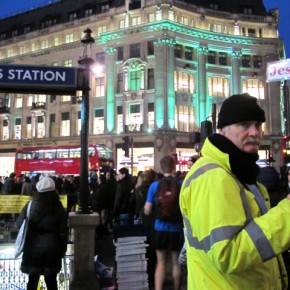I focused on one narrow strip of light seeping through a back window, set my exposure for 60 seconds and waited. In the middle of the shot, the garage door opened. The owner of the house started rolling his garbage can out towards the roadside. I didn’t want to explain why I was standing there with a camera aimed at his house. Especially late at night. Luckily, my exposure finished just in time for me to dart off into the dark without confrontation, so I slipped off with my tripod, making a note to myself that it is probably best not to photograph dirt yards the night before garbage day.
I started photographing the dirt yards of houses in the dark desert neighborhood near my house after spending over twelve years running at night through the same desert streets. I love running at night and getting lost in the dark. I wind my way through the roads until I don’t even know where I am. Sometimes, the only way I can find my way home is by following the contours of the mountains on the horizon. Other times, I only know what street I’m on from the familiar glow of TV in someone’s window or the way the light shines on a work truck in the drive.
In the part of town where I run, most of the houses sit on two-acre lots. Like most places in Tucson, Arizona, the yards are hard packed dirt. There is no grass, no pretense of taming or changing the land. Just dirt packed on dirt with some occasional gravel thrown on top. Sometimes the dirt is lined with rocks. Sometimes a cactus or desert tree grows out of the dirt. But the dominating feature of these yards is dirt and only dirt.
People keep their dirt tidy. They rake their dirt, sweep their dirt, take leaf blowers to it and blow the dirt around. They spend their weekend afternoons tending to their dirt. There are very few streetlights in Tucson and none out in these older suburbs, so when the dark sets in, it is very dark. The dirt yards are only illuminated by moonlight and starlight. They merge with the night, blend right into the surrounding desert and dissolve into nothingness. Dirt pushes right against walls of houses which stand like isolated fortresses in this unforgiving landscape.
The city sits on a giant colony of termites that migrate from deep under the dirt and into the walls of houses. Somewhere under the hard surface of the desert, a giant Queen Termite sends her minions into houses to bring the walls down. You have to look for the dirt they reshape in their wake, delicate tubes that snake up the sides of houses.
During the day, a dirt yard is just a dirt yard. At night it becomes something eerie and beautifully otherworldly. Small signs of domestic life glow faintly in a sea of darkness and dirt. The flicker of a television, the sulfur yellow of a single lamp, or a tiny rectangle of light from a bathroom window are the only things that indicate people actually live behind these walls. The domestic space seems so isolated, fragile and removed from the landscape that encroaches on it. Night pushes right up to the doors and windows. Little smears of light and the people they represent seem so small compared to the immensity of the desert and the night sky.
I began shooting my photos of dirt yards as a very personal art project. They combine the landscape of my home in Tucson; the history of my body, with all the miles it has run through these streets, past these houses; and my love of cinema. Every photo I take contains domestic secrets. A movie is playing behind those closed curtains. The photographs are like frames from a film of the domestic unconscious. A million stories stream through the windows glowing in the night.
Sometimes the blurred light behind windows seems to sigh when I pass. Other times, the windows will be as dark as the dirt yards, as though all life had been extinguished from inside. The photos evoke a kind of domestic calm from a distance, but the shots also are laced with an underlying quiet menace – a cinematic menacing calm.
There is a mystery and edge to the photos that is a result of the process. The randomness of shooting in the dark combined with the danger of photographing strangers’ private domestic spaces turns
the ordinary into the extraordinary and underscores the fragility of life as we attempt to contain and control it through the walls of our homes.
Shooting dirt yards at night is not easy. So many random factors come into play that if often feels like I have little control over the end result. Ultimately I have to wait and see what the dark is going to deliver. A myriad of random factors can change the way a photograph looks and feels – the phase of the moon, one porch light, a passing car, a constellation of stars. No matter how brightly lit the landscape appears to my naked eye, adjusted to the night, the back of my view finder is always pitch black.
If I’m lucky, I can catch one little spot of light and guess the composition from that point. It’s impossible to capture a truly mastered shot given all the uncontrollable factors – guessing the manual exposure, not being able to see anything through the viewfinder, trying to find something to focus on. The photos are always a crap shoot, but they are also a way of letting go and seeing what the dark has to say to me.
Then there is the sense of danger. I try to shoot from the street, but at times I have tip-toed through front yards and driveways to capture the shot I want. I shoot these photos with the constant threat of being caught, whether it’s by someone rolling their garbage can out to the roadside or something more sinister. My sixty-second exposures feel like sixty hours while I wait for them to finish processing so I can slip back into the night before being caught. In Arizona, the likelihood of people owning guns in these houses is very great. People like to feel protected and safe in their homes. Most would probably not feel very generous towards a strange woman standing in their dirt yard with a camera aimed at their windows.
Even when I do walk away bullet-free, I often come home with cactus needles stuck in my feet and legs from tramping through desert scrub in the middle of the night. The landscape itself with its vast variety of prickly plants – thorns, needles, thistles – is a risk factor. But the risk is worth taking. By photographing the very unique domestic landscape of Tucson, Arizona, I shed light on a sense of the human domestic unconscious – my own and others. The photos skirt the edge between interior and exterior, real and the surreal, dream and nightmare. They tap into places that reside inside all of us despite where we live and the kind of home we occupy.
The little islands of domestic space we carve out of this landscape seem so ill-placed. Somehow these houses with their dirt yards represent the tenuous hold all of us have on the planet. In the end, the TVs and the table lamps might still be standing, but we will all go back to dirt one way or another, from dust to dust.
Photographs courtesy of the author.
Kim Nicolini’s Dirt Yards at Night photos will be on exhibit in Miami, Florida as part of the show DIRT
YUTA SUELO UDONGO TÈ. The exhibition runs June 1-28, 2013 at Artlab33 in the Spear Building at 3815 NE Miami Court, Miami Design District. Send exhibit inquiries to <editor@miamiartexchange.com>. Souciant contributor Mark Hahn’s photographs of Ray Mine will also be on exhibit.











